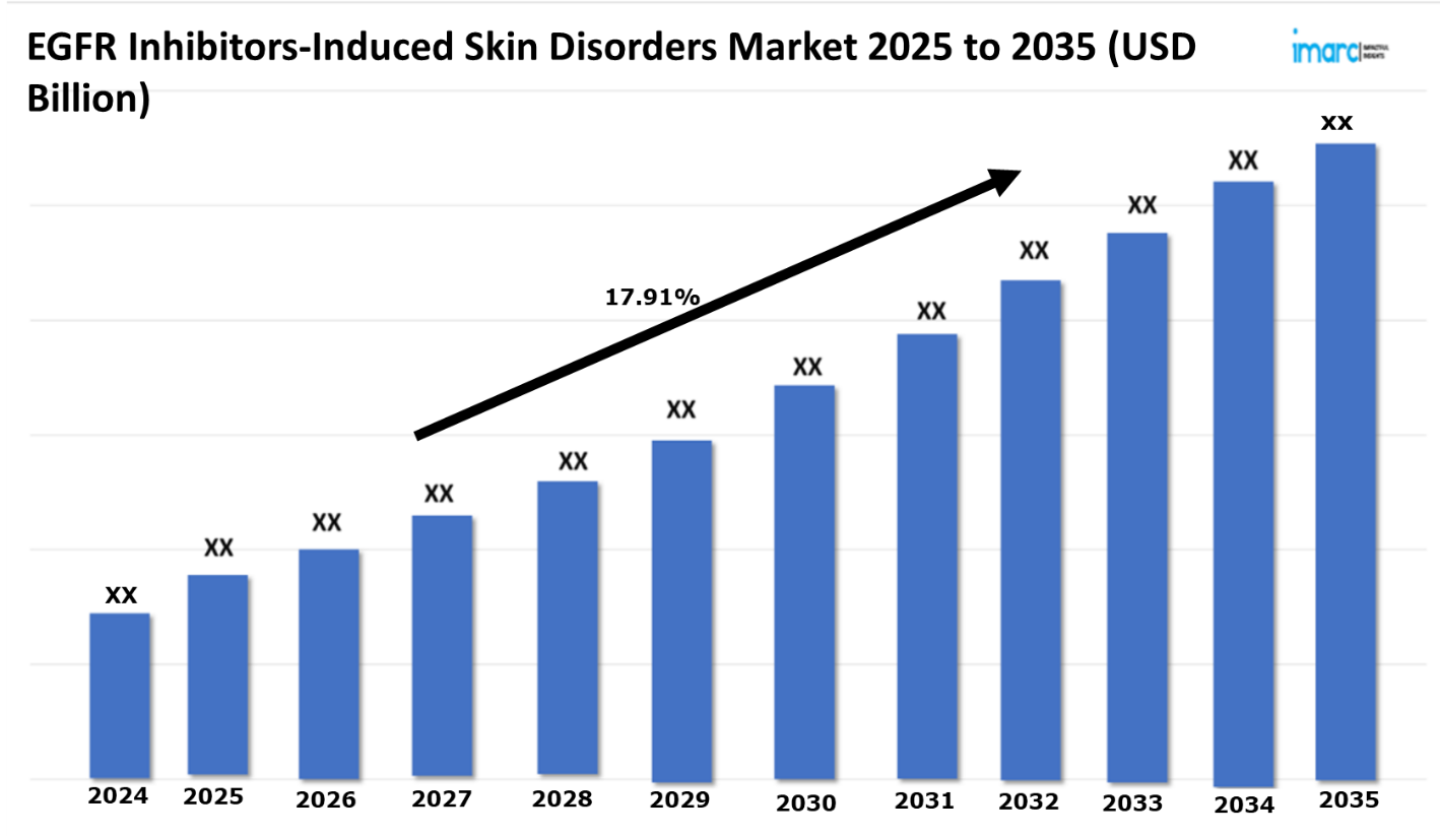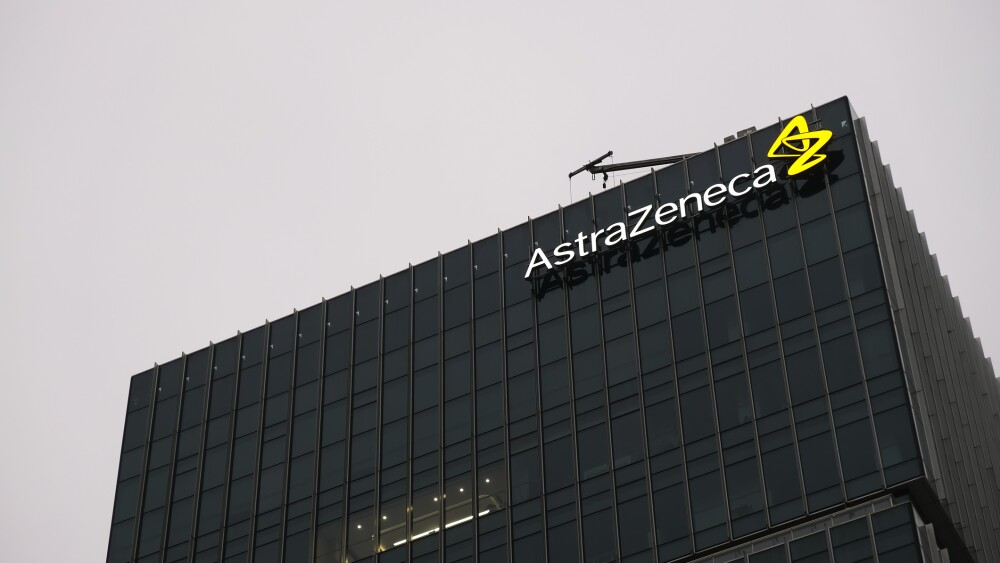EGFR Inhibitors-Induced Skin Disorders Market Outlook 2025-2035:
The EGFR inhibitors-induced skin disorders market is demonstrating a promising trajectory, with a projected CAGR of 17.91% across the 7 major markets between 2025 and 2035. The market is driven by the escalating application of personalized medicine, concentrating on minimizing adverse reactions while maximizing therapeutic efficacy. With advancements in genetic profiling and biomarker identification, clinicians can predict patient susceptibility to dermatological side effects from EGFR inhibitors. This enables early intervention and targeted therapies, such as customized topical agents, anti-inflammatory drugs, or biologics, to effectively manage skin conditions without interrupting cancer treatments. Personalized approaches enhance treatment efficacy, reduce adverse effects, and improve patient adherence to EGFR inhibitors. Supported by precision medicine advancements and ongoing research, this focus on individualized care is fostering market growth and improved patient outcomes.
Advances in Early Detection and Diagnostic Technologies: Driving the EGFR Inhibitors-Induced Skin Disorders Market
Early detection and diagnostic technologies significantly influence the growth of the market for EGFR inhibitors-induced skin disorders. Advanced diagnostic tools help identify and monitor these skin conditions early. The occurrence of skin changes in response to EGFR inhibitors is evaluated accurately with the help of dermatological imaging technologies such as high-resolution digital photography and confocal microscopy. These tools help clinicians keep track of disease progression and assess the efficacy of treatment in managing toxicities related to skin. Another aspect that propels the evolution of diagnostics is research on biomarkers. Early identification of patients likely to experience adverse effects from EGFR inhibitors is possible based on associated inflammatory markers and cytokines. This will allow appropriate dosing and appropriate supportive therapy, such as topical steroids and antibiotics, in anticipation of side effects, thus preventing more severe consequences. AI continues to aid dermatology with the capabilities of improved diagnostic accuracy and efficiency. In this regard, AI-powered algorithms analyze images of the skin to detect patterns and predict the possible severity of skin disorders, which will help clinicians decide. These factors are supporting growth in the market because of the improvement in personalized management strategies for patients undergoing EGFR inhibitor therapy. As diagnostic technologies continue to evolve, they not only improve patient outcomes but also support the development of targeted therapies, creating new opportunities in the EGFR inhibitors-induced skin disorders market.
Request a PDF Sample Report: https://www.imarcgroup.com/egfr-inhibitors-induced-skin-disorders-market/requestsample
Development of Novel Therapies and Pharmacological Treatments: Contributing to Market Expansion
Advances in new therapeutic and pharmacological agents are strongly driving the growth in the EGFR inhibitors-induced skin disorders market. Pharmacological advancements have led to the development of targeted treatments for these skin disorders. Topical and systemic treatments are being perfected that avoid inflammation, infection, and abnormal keratinization due to the inhibition of EGFR by using corticosteroids, antibiotics, and retinoids. In addition, biological therapies targeting inflammatory pathways are expected to provide promising solutions. For instance, the antagonists of IL-1 and IL-17 are under investigation to check their ability to blunt skin toxicity without impairing the efficacy of cancer treatment. Innovative combination treatments also improve outcomes. Pharmacological treatments combined with moisturizers, emollients, and agents for barrier protection have shown potency in managing xerosis and secondary infections. These combination treatments combine holistic care into the patient’s management, thereby enhancing adherence and quality of life. Advancements in formulations of drugs further fuel market growth. Technologies are developed with nano formulation techniques and sustained-release delivery systems, improving efficacy while minimizing the adverse effects of topical agents. They provide improved penetration and a prolonged therapeutic action that can be much needed in patients suffering from extreme reactions to the skin. Growing awareness regarding earlier intervention and more proactive management among healthcare professionals and patients further drives the demand for novel therapies. This focus on personalized medicine, through continued clinical trials and research, propels innovation in the EGFR inhibitors-induced skin disorders market toward improving patient care and therapeutic outcomes.
Buy Full Report: https://www.imarcgroup.com/checkout?id=11622&method=809
Regional Analysis:
The major markets for EGFR inhibitors-induced skin disorders include the United States, Germany, France, the United Kingdom, Italy, Spain, and Japan. According to projections by IMARC, the United States has the largest patient pool for EGFR inhibitors-induced skin disorders while also representing the biggest market for its treatment. This can be attributed to the emerging popularity of personalized medicine approaches, which are allowing healthcare providers to customize therapies based on genetic and clinical profiles, thereby improving patient outcomes.
Moreover, pharmaceutical advancements are another key market driver. The introduction of topical corticosteroids, anti-inflammatory agents, and biologics specifically designed for skin toxicities has provided effective options for managing these conditions without disrupting cancer treatments.
Besides this, the U.S. healthcare system’s advanced infrastructure supports early diagnosis and proactive management of these skin disorders. Innovative diagnostic technologies, such as biomarker-based screenings and high-resolution imaging, help clinicians identify skin-related side effects at an early stage, enabling timely interventions. This has driven the demand for targeted therapies tailored to manage these conditions effectively.
Key information covered in the report.
Base Year: 2024
Historical Period: 2019-2024
Market Forecast: 2025-2035
Countries Covered
- United States
- Germany
- France
- United Kingdom
- Italy
- Spain
- Japan
Analysis Covered Across Each Country
- Historical, current, and future epidemiology scenario
- Historical, current, and future performance of the EGFR inhibitors-induced skin disorders market
- Historical, current, and future performance of various therapeutic categories in the market
- Sales of various drugs across the EGFR inhibitors-induced skin disorders market
- Reimbursement scenario in the market
- In-market and pipeline drugs
Competitive Landscape:
This report offers a comprehensive analysis of current EGFR inhibitors-induced skin disorders marketed drugs and late-stage pipeline drugs.
In-Market Drugs
- Drug Overview
- Mechanism of Action
- Regulatory Status
- Clinical Trial Results
- Drug Uptake and Market Performance
Late-Stage Pipeline Drugs
- Drug Overview
- Mechanism of Action
- Regulatory Status
- Clinical Trial Results
- Drug Uptake and Market Performance
Ask Our Expert & Browse Full Report with TOC & List of Figure: https://www.imarcgroup.com/egfr-inhibitors-induced-skin-disorders-market/toc
IMARC Group Offer Other Reports:
Hyperpigmentation Market: The 7 major hyperpigmentation markets reached a value of US$ 3.4 Billion in 2023, and projected the 7MM to reach US$ 6.6 Billion by 2034, exhibiting a growth rate (CAGR) of 6.38% during 2024-2034.
Bacterial Skin Diseases Market: The 7 major bacterial skin diseases markets are expected to exhibit a CAGR of 6.56% during 2024-2034.
Small Cell Lung Cancer Market: The 7 major small cell lung cancer markets reached a value of US$ 8.2 Billion in 2023. Looking forward, IMARC Group expects the 7MM to reach US$ 19.1 Billion by 2034, exhibiting a growth rate (CAGR) of 8% during 2024-2034.
Chimeric Antigen Receptor (CAR) t-Cell Therapy Market: The 7 major Chimeric Antigen Receptor (CAR) T-Cell Therapy markets reached a value of US$ 3,589.7 Million in 2023. Looking forward, IMARC Group expects the 7MM to reach US$ 11,282.5 Million by 2034, exhibiting a growth rate (CAGR) of 10.85% during 2024-2034.
Plaque Psoriasis Market: The 7 major plaque psoriasis markets are expected to exhibit a CAGR of 8.93% during 2024-2034.
Atopic Dermatitis Market: The 7 major atopic dermatitis markets reached a value of US$ 16,816.8 Million in 2023, and projected the 7MM to reach US$ 37,213.7 Million by 2034, exhibiting a growth rate (CAGR) of 7.49% during 2024-2034.
Contact US
IMARC Group
134 N 4th St. Brooklyn, NY 11249, USA
Email: Sales@imarcgroup.com
Tel No:(D) +91 120 433 0800
Phone Number: - +1 631 791 1145, +91-120-433-0800





